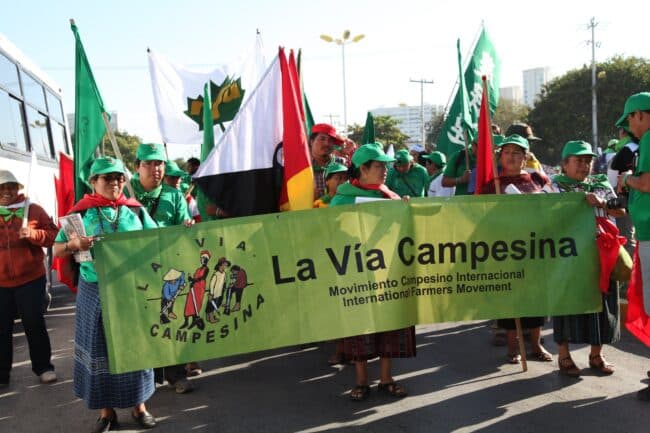
La Via Campesina’s concept of food sovereignty proposes a radical social transformation to make food systems more democratic. Source: Ian MacKenzie La Via Compesina/flickr, CC BY
On the Dec. 8, 2009 broadcast of Democracy Now!, Amy Goodman asked her guest, 15-year-old Mohamed Axam Maumoon, youth ambassador from the Maldives Islands to the U.N. climate talks in Copenhagen, for a message to young people everywhere about what climate change meant to him.
Without hesitation, Axam turned to the camera and asked, “Would you commit murder . . . even while we are begging for mercy and begging for you to stop what you’re doing, change your ways, and let our children see the future that we want to build for them?”
 What does it mean to take Axam’s question seriously? For many of us in the wealthy and so-called “developed” countries of the world, it means learning about the very real and life-threatening ways that climate change is affecting some of the world’s poorest populations.
What does it mean to take Axam’s question seriously? For many of us in the wealthy and so-called “developed” countries of the world, it means learning about the very real and life-threatening ways that climate change is affecting some of the world’s poorest populations.
From the rapidly submerging islands of the Maldives, Kiribati, and Tuvalu, to the melting permafrost in native lands across the Arctic, indigenous peoples around the world are confronting some of the worst effects of the climate crisis, despite having done so little to cause it. Axam’s question prompts us to confront the injustice of a situation in which the wealthiest 20 percent of the world’s population has been responsible for more than 60 percent of global warming emissions.
Download lesson to continue reading.
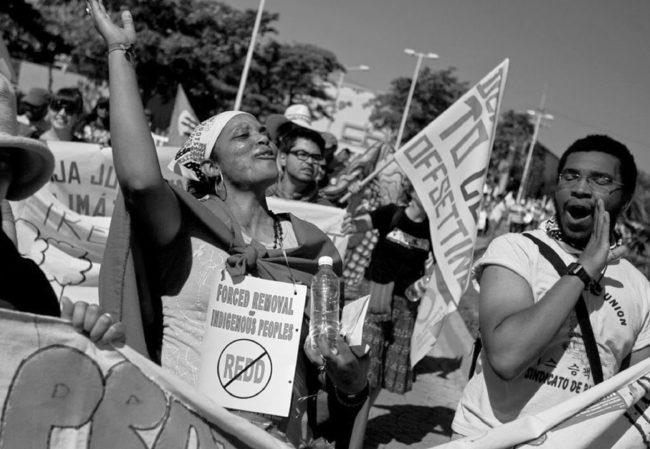
Indigenous people demonstrate at the 2010 climate change summit in Cancun. Source: Keri Koch.
Classroom Stories

We used materials from the Zinn Education Project, Rethinking Schools, and Teaching for Change with our 7th grade to create an interdisciplinary, experiential project that explored Indigenous Perspectives on Climate Change. It was the perfect way to tie together our humanities unit on Indigenous Perspectives on American History with the STEM unit on deep time and extinction-level events.
Our students prepared for the ‘Don’t Take Our Voices Away’ indigenous people’s climate summit simulation as a final learning demonstration. Taking on the perspectives of various indigenous groups was something our students took seriously as they researched both the cultures and climate challenges faced by the groups. Then, at the summit, they did presentations that explained the priorities and needs of those groups before launching into negotiations about how to best communicate those perspectives with the rest of the world.
Leading up to the summit, we took a climate justice gallery walk using photos shared on the ZEP website, researched indigenous climate activists, and also did the Meet Today’s Climate Justice Activists mixer. Those activities were the perfect scaffold to the summit. Overall, I saw my students develop deep understanding and empathy through the interactive and experiential materials provided by the Zinn Education Project.
I am grateful to have participated in a workshop where I learned how to use them. Now that I am at a school where our model centers experiential project based learning, these materials have become an invaluable resource.

I used ‘Don’t Take Our Voices Away’: A Role Play on the Indigenous Peoples’ Global Summit on Climate Change to lead an asynchronous online discussion with my environmental science students about the effects of climate change on marginalized communities. My students are often VERY quiet and discussions are hard. Additionally, many available resources for climate change teaching is not appropriate for a college level course. This one being asynchronous and the content matter really seemed to open them up.
They shared personal stories about how their families would be affected and admitted to not even knowing some of these groups existed. We discussed the specific impacts in our area, and how as a land grant institution, we live and learn on the lands of the Cherokee people everyday. Both the students and I learned a lot about each others’ perspectives and heard voices from many other communities. I could not recommend the assignment more for anyone looking to explore teaching climate change effects on communities with their class.

I’m a Participation in Government teacher at Metropolitan Expeditionary Learning School, a public 6-12 school in Queens, New York. We have some latitude to design our own curriculum at my school, and given our motto as a “school for a sustainable city,” with a focus on designing learning experiences around environmental and social justice, we work to thread the climate crisis into many of our case studies across the disciplines.
This year, we wanted to kick off the semester in Government class by thinking about ways in which people traditionally, and non-traditionally, “participate in government.” We also wanted to explore on-going fights where communities rise up against the confluence of big business, fossil fuel companies, lobbyists, and dark money to fight to protect the Earth. The Zinn Education Project’s Teach Climate Justice resources were a boon to spark our curricular thinking.
Using the Don’t Take Our Voices Away role play as inspiration, we decided to teach and learn deeply about the Dakota Access Pipeline Fight as a way to better understand indigenous peoples’ perspectives on climate, and also to analyze the heroic methods and strategies used by #noDAPL protesters to make their voices heard. Teaching the role play over a few days to build background knowledge, we wanted students to be able to empathize with the stakeholders in this fight in order to better understand the stakes, and the resources, both natural and financial, at play in this particular issue. Without much other context, we jumped right into the role play. Once all of the DAPL stakeholders were named and their arguments analyzed, we were then able to dig into the context behind each of these positions.
In order for students to understand the ways in which people power with limited resources (as the Standing Rock Sioux exemplified) can strategize and make their voices heard, students needed to investigate the levers of power. So, we introduced our students to an old chestnut of community-based organizing strategy: power mapping.
Using the Midwest Academy framework and the resources from Zinn to provide primary and secondary source support, students power-mapped (and backwards power-mapped) the DAPL fight. They thought about specific targets — or stakeholders they wanted to move — as they designed short-, medium-, and long-term goals to achieve their organizational aims and to move stakeholders.
These frameworks allowed students to explore the roots of grassroots organizing. With with the examples provided by the Standing Rock Sioux and the curricular supports provided by the Zinn Education Project, the power mapping exercise was not just theoretical for my students, but was a case of real stakes and the struggle for climate justice.

There are few lessons that I enjoy teaching more than ‘Don’t Take Our Voices Away’: A Role Play on the Indigenous Peoples’ Global Summit on Climate Change in my science classroom. In part, because it gives tangible details and a human face to the issue, not just a story of polar bears or talk about temperature. This is missing in a lot of the science curriculum we are provided. Likewise, the voice of indigenous people in the world is something quite absent in our westernized science curriculum, which is maybe not surprising because these voices are also being left out of world decisions. Those points are what drew me to teaching the lesson. I keep teaching it because of how my students respond. They enjoy the structure of the activity, that they have some agency and control in what happens, as they get to take on the roles and make proposals.
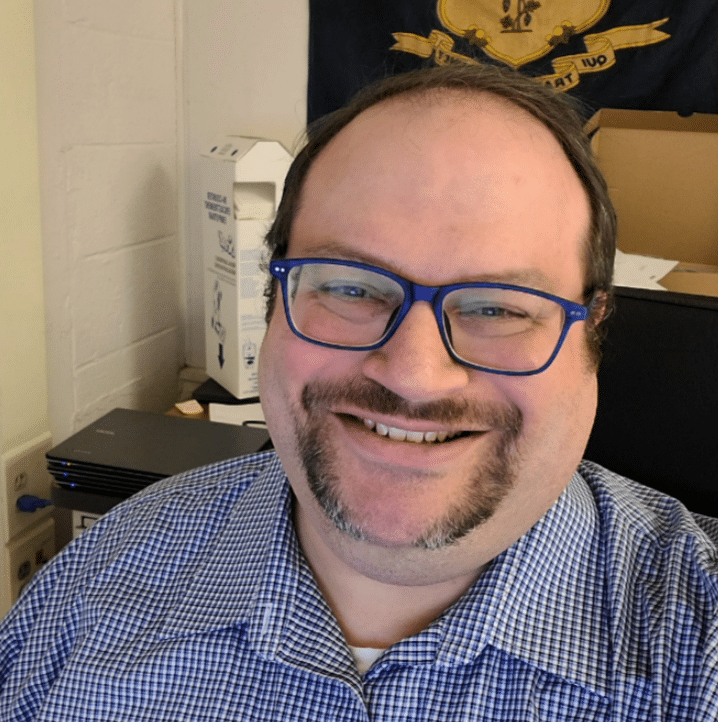
My district ends the 7th grade social studies curriculum with a look at the Columbian Exchange and the short-, medium-, and long-term effects of the exchange, including but not limited to the trans-Atlantic slave trade and European murder of Indigenous peoples of the Americas. Because these themes will be repeated in 8th, 9th, and 11th grades, the 7th grade focus is mainly on Columbus and the Spanish conquistadors, as well as the affects of the slave trade on sub-Saharan Africa. As a result, as an attempt to show the long-term effects of this interaction, I have used a few selections from ‘Don’t Take Our Voices Away’: A Role Play on the Indigenous Peoples’ Global Summit on Climate Change, specifically the testimonials from the Taíno/Caribs/Arawaks, the peoples of the Amazon, and the Bambara.
Although it is framed around the question, “what are the long-term consequences of European interactions with Africa and the Americas,” I have found students to be extremely receptive to the messages about climate change. They are, after all, going to be the inheritors of the Earth, and many of them, even in middle school, are keenly aware of the dangerous effects of climate change we are beginning to see. We discuss the lack of power these groups have in advocating for their needs in our “post-colonial” system, and the fact that each of these groups is suffering but still needs to ask for help is not lost on many students.
 This teaching activity was originally published by Rethinking Schools and is included in A People’s Curriculum for the Earth.
This teaching activity was originally published by Rethinking Schools and is included in A People’s Curriculum for the Earth.
Additional Resources
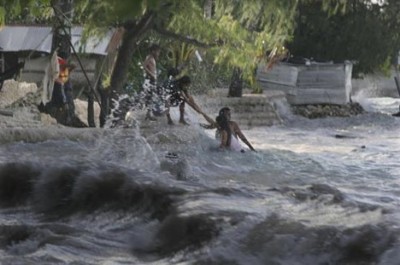 Paradise Lost. PBS NOW traveled to the nation of Kiribati to see up close how climate change affects residents’ daily lives and how they are dealing with the reality that both their land and culture could disappear from the Earth. NOW also traveled to New Zealand to visit an I-Kiribati community that has already left its home, and to the Pacific Island Forum in Niue to see how the rest of the region is coping with the immediate crisis of climate change. [Producer’s description.] This film can be viewed for free online. It was used in the classroom and is recommended by the teachers who wrote “‘Don’t Take Our Voices Away’: A Role Play on the Indigenous Peoples’ Global Summit on Climate Change.” |
 The Island President tells the story of President Mohamed Nasheed of the Maldives. After leading a 20-year pro-democracy movement, surviving repeated imprisonments and torture, Nasheed becomes president at 41, only to encounter the crisis of climate change. Considered the lowest lying country in the world, a rise of a mere three meters in sea level would inundate the 1,200 islands of the Maldives, rendering the country practically unlivable. [Producer’s description.] |
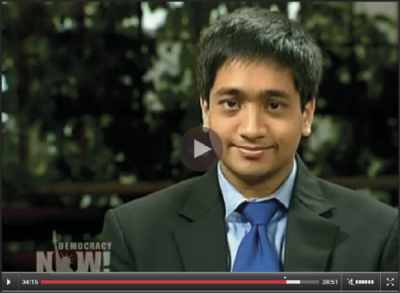 Democracy Now! interview with Mohamed Axam Maumoon, the 15-year-old environmental ambassador from the Maldives, challenging Western viewers by asking, “Would you commit murder?” |
 Democracy Now! clip featuring youth activist Kari Fulton speaking at the U.N. Climate Change Conference in Cancun, Mexico: “We want people to know that whether you live in the forest, whether you live in the hood, you will be impacted by false solutions.” |
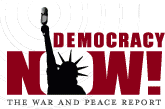 Coup in Maldives: Adviser to Ousted Pres. Mohamed Nasheed Speaks Out from Hiding as Arrest Sought. Democracy Now! broadcast, 2/9/2012. |
Lessons, books, films, and websites for teaching about climate change in K-12 classrooms. |








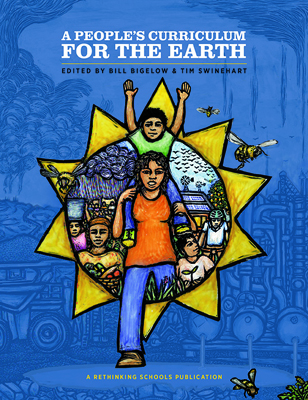









Twitter
Google plus
LinkedIn